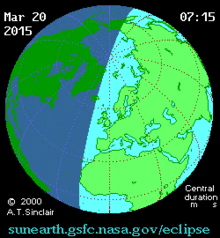A partial solar eclipse on March 29, 2006, passed over Germany, but the country only had around 2 GW of PV installed at the time. Another one crossed Germany on August 1, 2008. In the North, the partial eclipse reached 23 percent but fell below 10 percent in the South. The country had less than 5 GW of PV that summer.
The next one came on January 4, 2011 – a day with very little sunlight – and had completely left Germany by 10 AM. Germany had 24.4 GW of PV at the time.

But on March 20, 2015, a solar eclipse will pass over Norway, covering all of Western Europe partially. Germany will be affected roughly from 9 AM to around 11 AM. And it will probably have more than 37 GW of PV installed.
What will the effect be that day? It depends on the weather – to give you an idea, I went back to mid-March 2014 to see how much solar power was generated (see below).
On March 20, solar power production peaked at an impressive 23 GW, but on March 16 the country’s PV arrays only managed to peak at five GW. In other words, next year during the solar eclipse, Germany might ramp up quickly from a low level to five GW – or maybe to 23 GW.
The difference is crucial for power companies and grid operators, however. If it were a total eclipse near midday, Germany would go from zero GW of PV to around 23 GW in just one hour. But since the country will only have a partial eclipse that day, it might go from 12 to 23 GW in just one hour.
It’s a lot, but the country actually ramps up solar close to that level every day. For instance, last year on March 20 solar power was at 15 GW at 9 AM and 22.3 GW at 11 AM (see Agora’s chart above). That’s 7.3 GW in two hours on a normal day. Next year, we might ramp 50 percent more in half the time.
The industry insider who tipped me off to this issue tells me that power firms are already holding meetings to discuss how to deal with the situation. But it could be worse – Germany could easily have twice as much solar as it does today in the long run, and a full solar eclipse on a summer day would be a far greater challenge. But not to worry – the next total solar eclipse will not be seen in Germany until September 3, 2081.
Source: Renewables International. Reproduced with permission.









